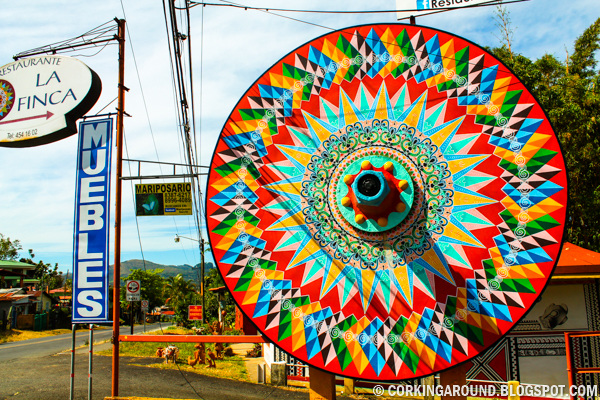Arenal Volcano
Several years ago in 2012--way before I conceived the idea of starting a travel blog--I visited Costa Rica for the first time with a friend. Unfortunately, back then I didn't keep a journal of what I did each day, so I've lost a lot of detailed memories about my trip. Fortunately, though, I did take lots of pictures, so at least I have these to jog my memory!
One of the first things I did when I visited was take a bus to Volcán Arenal, or Arenal Volcano. Along the way from Heredia, where I stayed, to the volcano were plenty of colorful shops against Costa Rica's wonderfully lush landscape.
The 5,357-foot Arenal Volcano is located in Arenal Volcano National Park, a 29,692-acre swatch of land within the expansive 504,094 acres of the Arenal Conservation Area. The conservation area protects 16 reserves between the Tilarán and Guanacaste mountain ranges where there's a an incredible amount of biodiversity.
The national park also encompasses the 3,740-foot Chato Volcano, which has been inactive for approximately 3,500 years. In contrast, Arenal is the country's most active volcano. Lava flows have been consistent since July 29, 1968 when three craters opened on the western flank of the volcano. What we call "Crater A," which measures over 3200 feet across, set off a flow of toxic gas and hot rocks that spread over 7 miles and killed 87 people in the towns of Pueblo Nuevo and Tabacón. In September of 1968 "Crater A" started to emit lava again and remained the most active of the craters until 1973.
In 1973 "Crater C" became the most active and remains so today. As of 2010 the volcano's seismicity and lava flows have decreased. However, this only means that it's sleeping and remains quite active. During the day you can apparently see smoke and cinder blocks flowing from the top, but as you can see the clouds were settled on top of the volcano obscuring our view. It was still quite majestic to stand at the foot of a volcano, though!
At the base of the volcano is Lake Arenal, which supplies the country with 12% of its hydroelectric power. It tripled in size when, in 1979, a hydroelectric dam was installed. The lake now sits over the original locations of the towns Arenal and Tondadora, which were relocated to the northeastern side of the lake. Noted as Costa Rica's largest landlocked body of water, the lake covers 33 square miles and reaches depths of around 200 feet.
There are also short trails within the national park for those that have time to spend hiking. They pass through secondary forests and lava fields from previous eruptions, providing a glimpse into recent geologic history. Since we were on our way to the Tabacon Hot Springs, we didn't have enough time to go on any short hikes, though I would have loved to better explore the park!
Since I live in an area that has no volcanoes whatsoever, I was incredibly excited to see this in person. My first active volcano sighting! I obviously recommend taking the time to visit the park to see Arenal Volcano, especially if, like me, this is your first time cozying up to an active cone.











Comments
Post a Comment